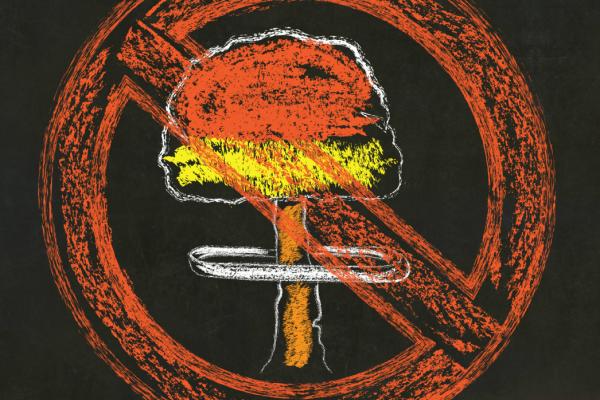IMAGINE IF YOU will a world in which the most destructive weapons were “conventional” explosives. These bombs, often with nicknames such as “Daisy Cutter” or “bunker buster” or even the “Mother of All Bombs,” have enormous power: The Vietnam-era Daisy Cutter, one of the largest conventional weapons ever used, was designed to flatten a forest into a helicopter landing zone with a blast equal to about 15,000 pounds of TNT.
Now imagine that someone says, “Those conventional bombs aren’t destructive enough. Let’s invent a weapon a million times more powerful, one that releases radiation that magnifies the killing effects for generations. And let’s make 16,000 of those weapons.”
A sane world would respond, “You’ve gotta be kidding.”
But in the real world, it’s no joke.
Today, 70 years after the attacks on Hiroshima and Nagasaki in 1945, the world has 16,400 nuclear weapons—93 percent of them in the arsenals of the U.S. and Russia. The first H-bomb had the force of around 10 million tons of TNT, more than a million times as powerful as the worst conventional weapons.
So in some ways it comes as no surprise that first responders—groups on the front lines of dealing with disasters—have become leaders in the movement to abolish nuclear weapons. For organizations such as the International Committee of the Red Cross, the reasoning is clear: There simply is no way to adequately respond in the aftermath of a nuclear explosion. Thus the Red Cross has called for legally binding steps toward the complete elimination of nuclear weapons.
And for the first time ever, so has the pope. In December, the Vatican delivered a statement to the Vienna Conference on the Humanitarian Consequences of Nuclear Weapons, which was hosted by the government of Austria “to strengthen the global nuclear disarmament and non-proliferation regime.” The Vatican statement, titled “Nuclear Disarmament: Time for Abolition,” argued that “the very possession of nuclear weapons, even for purposes of deterrence, is morally problematic.”
That’s a big deal—in the past, the Vatican and other religious institutions have given their “conditional acceptance” of nuclear weapons in the context of deterrence. Now, the Vatican says, “the system of nuclear deterrence can no longer be deemed a policy that stands firmly on moral ground” and thus “The time has come to embrace the abolition of nuclear weapons.”
It may not be obvious (yet) here in the United States, but there’s a vigorous and growing movement in Europe and elsewhere that’s working to make real that vision of a nuclear-free world. The International Campaign to Abolish Nuclear Weapons—a coalition of more than 360 organizations in 90-some countries—hosted a two-day conference in conjunction with the governmental gathering in Vienna.
The conference, with the unofficial theme of “We are the ones we’ve been waiting for,” was the largest ever civil society gathering on the abolition of nuclear weapons, with 600 participants from more than 70 countries. Topics ranged from the consequences of nuclear explosions to the moral and ethical responsibility to prevent them; the substance was equal parts factual, strategic, and inspirational. Hope, and perhaps precedence, was found in recent successful efforts to ban land mines and cluster munitions, and other work against chemical and biological weapons.
2015 is an important year regarding nuclear weapons, with the Non-Proliferation Treaty review conference in April, the 70th anniversary of Hiroshima and Nagasaki in August, and other events. And the worldwide movement to abolish nuclear weapons is encouraging. A key question is, will it jump the pond?

Got something to say about what you're reading? We value your feedback!
